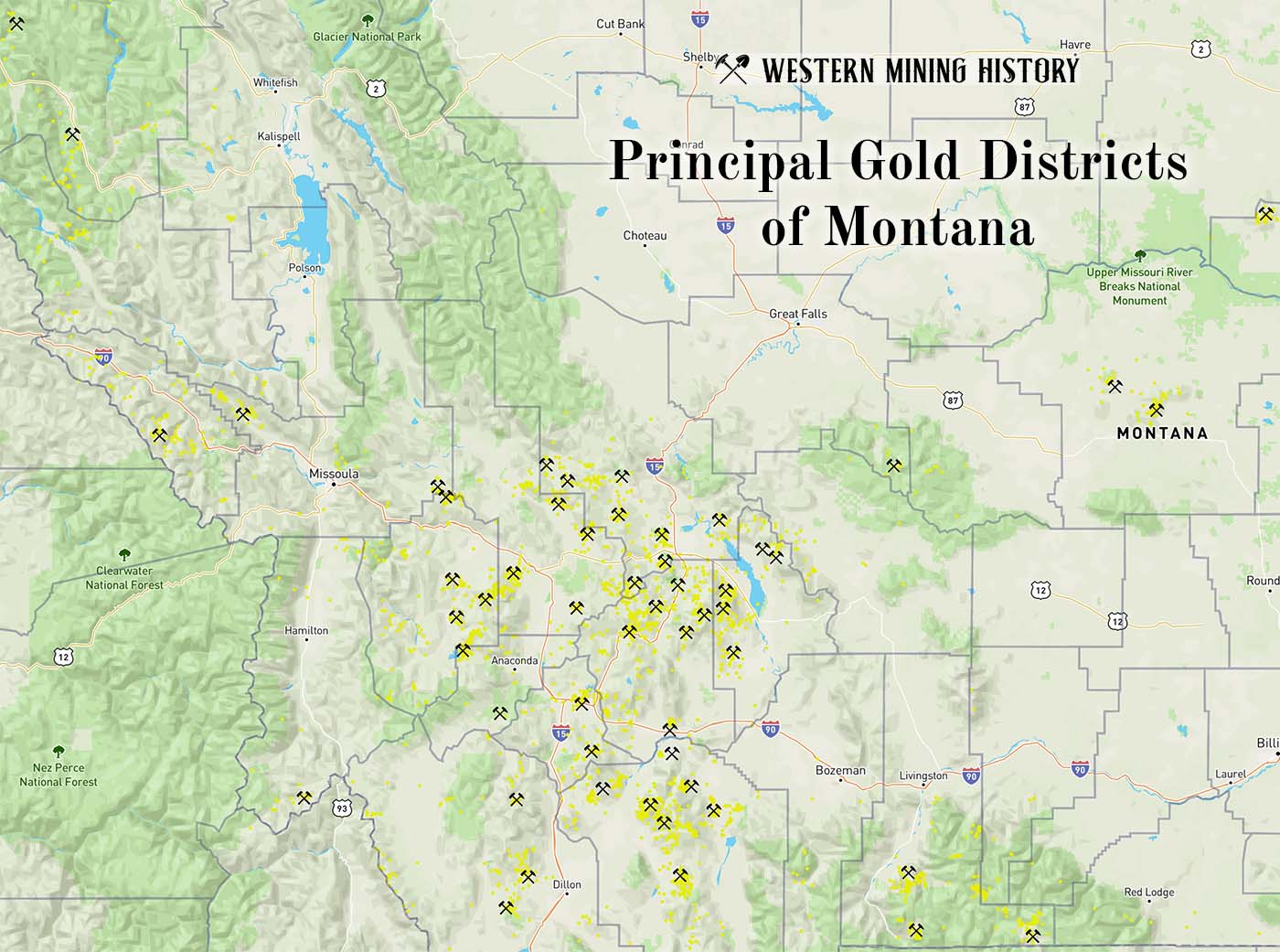The Marietta Mine is a silver and gold mine located in Madison county, Montana at an elevation of 7,720 feet.
About the MRDS Data:
All mine locations were obtained from the USGS Mineral Resources Data System. The locations and other information in this database have not been verified for accuracy. It should be assumed that all mines are on private property.
Mine Info
Elevation: 7,720 Feet (2,353 Meters)
Commodity: Silver, Gold
Lat, Long: 45.21722, -111.96028
Map: View on Google Maps
Mine Description
Discovered on June 2, 1903, by William Hill, John A. Anderson, and Bert Ferguson, and patented on August 21, 1935, the Marietta mine explores two veins: the Marietta vein, which trends slightly northeast, dips east 350 to 400 and is 2 to 2.5 ft thick, and the Metallic vein, which strikes N 450 E, 350-500 SE and is about 5 ft thick. The same veins or vein systems appear to be explored in the Irene, High Up, and Greenback mines to the northeast. They are lenticular quartz veins, with quartz boudins and free gold, auriferous pyrite, arsenopyrite, galena, sphalerite, chalcopyrite, and stibnite (?). The mine developed separate ore shoots on the two veins, with strike lengths of 300 to 350 ft, and stopes reaching 200 to 300 ft above the crosscuts and drifts on the veins. The veins were oxidized to a depth of about 300 ft. In 1938, average assays of the ore ranged from $9 Au per ton to $10.79 Au per ton. Assays of ore remaining in the mine in 1938 averaged 0.21 to 0.34 opt Au and 1.2 to 3.7 opt Ag.
The Marietta and Metallic veins were mined separately. The Marietta vein is opened by an east-to southeast-trending crosscut that intersected the vein at the 740-ft point, and drifts were run on the vein for about 460 ft north and 100 ft south. A stope about 400 ft long and 120 to 160 ft high was mined mainly above the north drift. An inclined winze about 75 ft deep was sunk on the vein near the crosscut entrance, and drifts run 140 ft on the vein at the 70-ft level.
The Metallic vein was cut in the Marietta crosscut about 160 ft beyond the Marietta vein, and drifts were run along it for 720 ft to the northeast and 690 ft to the southwest. The vein was stoped 60 to 80 ft above the northeast drift for a length of about 150 ft, and a raise extended to the surface. A winze was also sunk about 195 ft on the incline near the southwest end of the drift, and levels and stopes extended to both the northwest and the southeast on the vein at the 110-ft and 195-ft levels, totaling about 300 ft on each level. Another winze was sunk about 95 ft beneath the 195 level, but the vein at this level was not developed.
The Metallic vein also was intersected in an adit that crosscut about 100 ft to the vein. A drift was run along the vein about 270 ft to the northwest, and the vein was stoped to the surface. The total production from the Marietta mine is unknown. The mine was a significant producer from 1919 to 1922 and in the 1930s (figs. 19,20). Its last known production was in 1938. From 1935 to 1938, the mine yielded 25,332 tons of ore valued at more than $200,000. Most of this ore came from the stopes on the Metallic vein where it is cut in the Marietta crosscut, and from the stope to the surface in the Metallic adit. The total yield from the mine is probably between $400,000 and $500,000.
Source: The Gold Mines of the Virginia City Mining District, Madison County, Montana. Montana Bureau of Mines and Geology. Bulletin 133, 2004
Marietta Mine MRDS details
Site Name
Primary: Marietta Mine
Secondary: Marietta and Metallic
Commodity
Primary: Silver
Primary: Gold
Location
State: Montana
County: Madison
District: Virginia City Region - Browns Gulch District.
Land Status
Not available
Holdings
Not available
Workings
Not available
Ownership
Not available
Production
Not available
Deposit
Record Type: Site
Operation Category: Past Producer
Operation Type: Unknown
Years of Production:
Organization:
Significant: N
Deposit Size: S
Physiography
General Physiographic Area: Rocky Mountain System
Physiographic Province: Northern Rocky Mountains
Physiographic Detail: Gravelly Range
Mineral Deposit Model
Not available
Orebody
Not available
Structure
Not available
Alterations
Not available
Rocks
Name: Gneiss
Role: Host
Age Type: Associated Rock Unit
Age Young: Late Cretaceous
Name: Gneiss
Role: Host
Age Type: Host Rock
Age Young: Late Cretaceous
Analytical Data
Not available
Materials
Ore: Galena
Comments
Comment (Location): LOCATED ON NORTH SIDE AT EAST END OF BARTON GULCH.
Comment (Workings): PRODUCTION FROM TWO VEINS, THE METALLIC VEIN AVERAGING 5 FT. IN WIDTH, AND THE MARIETTA VEIN WHICH AVERAGES 2 - 2 1/2 FT. MILL WAS PRESENT ON SITE.
References
Reference (Deposit): LORAIN, 1937, GOLD LODE. MINING - TOBACCO ROOT MOUNTAINS, U.S. BUREAU MINES INF. CIRC. 6972
Reference (Deposit): MBMG MEM 9, P. 49.
Reference (Deposit): MBMG MEM 15, P. 51.
Reference (Deposit): 1933 RECON MBMG MEM
Reference (Production): LORAIN, 1937, U. S. B. M. INF. CIRC. 6972.
Principal Gold Districts of Montana

In Montana, 54 mining districts have each have produced more than 10,000 ounces of gold. The largest producers are Butte, Helena, Marysville, and Virginia City, each having produced more than one million ounces. Twenty seven other districts are each credited with between 100,000 and one million ounces of gold production. Read more: Principal Gold Districts of Montana.